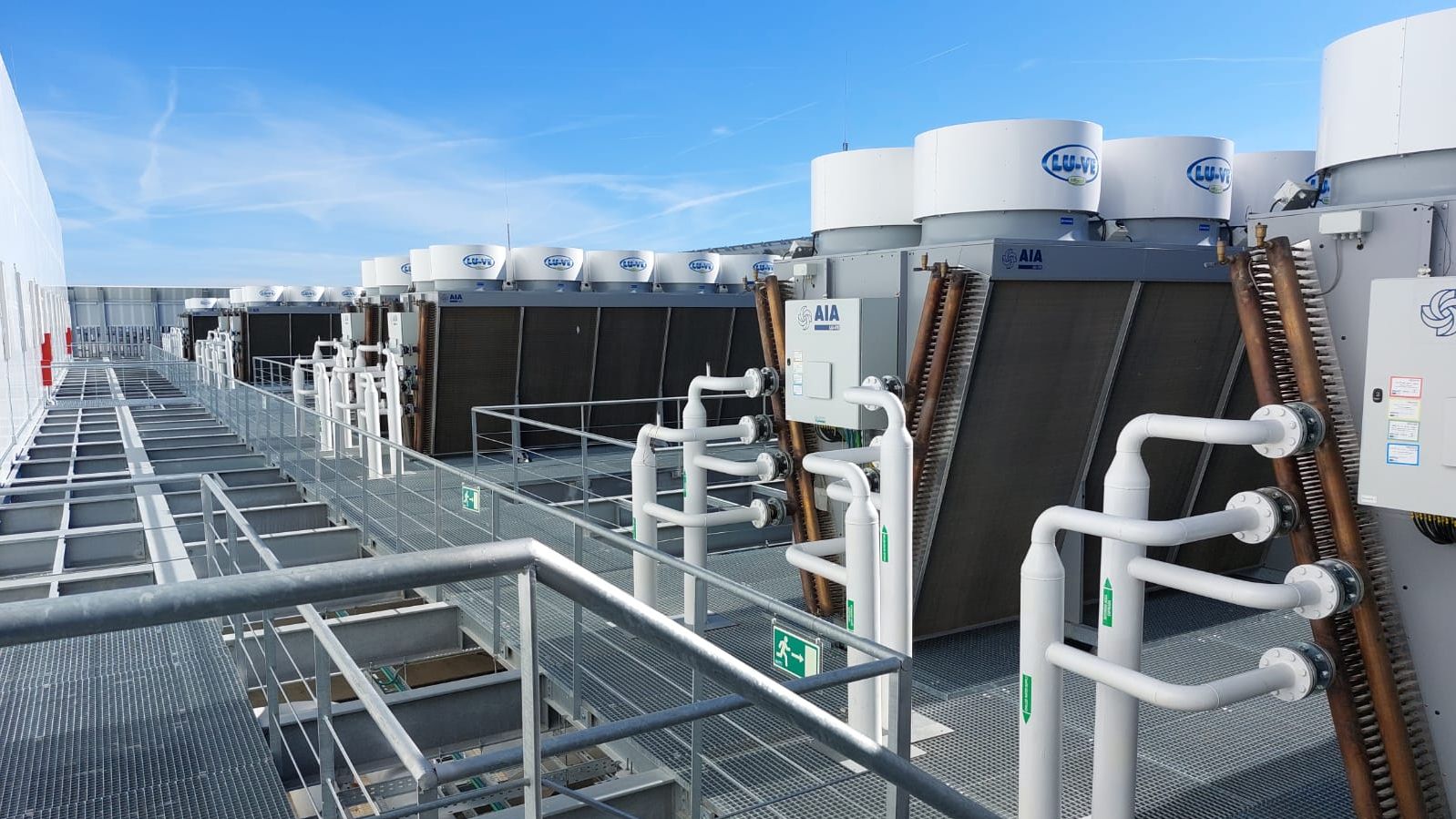At first glance it looks like a normal building, a modern office block in an old industrial area in the Madrid neighborhood of San Blas. However, Its interior houses vital infrastructure in our daily lives.and that will become even more important as digitalization expands into all areas of our lives.
This is the MAD4 data center, owned by the company Digital Realty, the largest in the Spanish capital, and the fourth that this company – previously called Interxion – opens in the city. RTVE.es has visited these facilities, which began operating last year, and which houses the servers of 400 clients, including IBM, Banco Santander, Ferrovial, Netflix, Disney+, Correos or Renfe.
Its expansion is a reflection of the dynamism of a sector that has put Spain in its sights. Only in the last two years technological giants such as Amazon, Meta (owner of Facebook, Instagram and WhatsApp) and Microsoft have announced million-dollar investments to open large data centers in Aragon, Madrid or Toledo.
Public administrations, from the Government to the town councils, have given a warm welcome to these facilitiesalthough the “macrocenters” also arouse suspicions among neighbors due to their water and energy consumption.
In the background, the racks with the servers in a room not yet filled
65% of the peninsula’s internet traffic passes through these centers
MAD4, however, is far from the size of large facilities like those of Jeff Bezos’ company in Zaragoza. It has about 35,000 square meters of space to house its clients’ servers and an electrical capacity of 30 MW. But how exactly does a data center work?
“We are the landlord of the internet,” explains Robert Assik, general director of Digital Realty, at the beginning of the visit. Your company puts the “physical part” so that others can install their computers here, something similar to what happens in an airportexemplifies. The company that operates Barajas, Aena, is not the owner of airlines, but rather provides “a common shared infrastructure that other companies use.”
The wiring used in this company’s centers could go around the world three times
Here the data is the equivalent of the passengers. And just as these “do not stay to sleep” at the airport, in a center like this “the data comes from one place and goes to another,” says Assik.
Specifically, for the data centers of this company in Madrid Approximately 65% of Internet traffic passes through the peninsula and approximately 15,000 connections are made. Its facilities house 120,000 kilometers of fiber cabling, which could go around the world three times.
Be close to the user so that data travels quickly
Having cutting-edge technology and a good connection is essential for data to travel quickly. And for that, so that users can have access to digital services in a short time, it is important to be “close to the user”, in places with high demand and geographic centrality such as Madrid. “When I order Netflix streaming at home, it goes to a machine here, not in the United States,” explains the head of the company.
Other types of centers, such as those of Amazon or Microsoft, where they “manufacture” the digital product, may be further away from users and in less populated areas, while facilities like these are needed for distribution.
Not in vain, this neighborhood of San Blas, due to its location and the previous presence of a powerful energy infrastructure, has become the area with the highest concentration of data centers in Spainwith a dozen facilities from various companies.
14 hours – Journey to the data center: these are the pillars that support the Internet – Listen now
Large rooms with 13,000 servers
The interior of the building is silent, with only a few cleaning and maintenance workers passing through it, since the processes are automated. The heart of the data center is the large, open rooms in which the clients’ servers are stored, 13,000 in each of them —The center has capacity for 150,000 in total—.
Most of them are not yet full, since the center is recently built, but 90% of its capacity has already been sold. The data passes through powerful computers that are stored in columns—called racks—and some of these groups of columns have special security as requested by the client.
It is also striking that the rooms are completely spotless. Everything here is cleaned several times a day, including the walls and doors, and the meter-deep false floor under the servers is lifted once a month to be thoroughly cleaned. The reason, explains Raquel Figueruelo, director of Marketing and Business Development at Digital Realty, is the danger that dust can have on the operation of computers, especially if it accumulates.
A water circuit to cool servers that never turn off
Servers never turn off to keep digital services running and for a matter of efficiency – turning them off and on would entail high consumption – and their operation 24 hours a day, 365 days a year emits a large amount of heat.
To cool them down, a closed water circuit system. The servers are located so that the heat output of all of them is concentrated in the same direction and there they create the so-called “cold corridors”, isolated from the rest of the room.
Pipes with chilled water to cool the servers
Through this cooling system, pipes carry cold water that passes next to the heat source and, once they have been heated, they raise the water again so that it is cooled again in a machine located at the top of the building.
As Assik points out, This achieves zero water consumption. The main expense occurs when the tank is filled for the first time—something they did when they opened the center and they have not repeated it—and otherwise the day-to-day use of water at the center “is much lower than expected.” that a family uses at home,” he says, showing the monthly bills.
Cold corridor to dissipate the heat generated by the data center servers
A 90% increase in energy efficiency
The refrigeration process has not changed since they opened their first center in 2000, at the dawn of this digital society, although they have “gained in efficiency in the production of cold”the main energy consumption of an infrastructure like this, says the director of Digital Realty.
At that time, to dissipate the heat generated by one kilowatt (kW) of energy, two kilowatts were needed, while technological development has meant that “this ratio has greatly improved.” They now need just 0.3 kW to extract one kW of heat, a “90% increase in efficiency”. Furthermore, all the energy they consume is 100% renewable, he highlights.
This machine cools the water which is then distributed throughout the rooms
The visit continues to the roof, where you can see another of the key elements to reduce energy consumption. They are large outdoor machines that naturally cool the water using the method known as freecoling.
They work especially at night, when temperatures drop, and to a greater extent in winter. In general, the company explains, they come into play when the air temperature is below 24 degrees, resulting in energy and economic savings. On the same roof there are also large generators prepared for the hypothetical case of a power outage.
Generators on the roof of the building to maintain operation in the event of a possible power outage
Artificial intelligence, a “very big qualitative leap”
The center is in the midst of construction of the second phase, a rapid growth that Assik explains in this way: “We opened the first center in 2000 and it took us 12 years to fill it. The second took six, and the third, three.”
This one, which has only been open for a year, is already practically fully booked. “Instead of making the mistake of making it too small, It is more than double that of the first three combined.“he points out.
Artificial intelligence is largely behind this growth, which has revolutionized the sector. “In the year 2000, a rack used 2 kW, now the range is between 5 and 10, Now with artificial intelligence we are going to go up to 80 and 100 kW. “It’s a very big qualitative leap,” exposes.
The MAD4 expansion is being built on the first site, while in the background, with the cranes, a future Treasury headquarters is being built that will also house its own data center.
This expansion of AI is largely what worries sectors opposed to the expansion of data centers, but this company highlights its limited impact since they use renewable energy. Besides, “the digitalization of society causes per capita CO₂ emissions to drop“Assik assures, according to a study commissioned by Digital Realty and prepared by the consulting firm Analistas Financieros Internacionales (AFI) in 2021. He insists that they do not compete for the same energy resource with other uses – another of the common criticisms – since ” “Spain has the capacity to produce more than double the energy of what it needs as a country.”
“We come from a productive economy and we are entering the data economy, which is what artificial intelligence will serve. “As a society we can return to the caves or be in the data economy”points out Figueruelo, and to do this, remember, we need infrastructure, which, just as in the past it has been train tracks or highways, now it is data centers.


